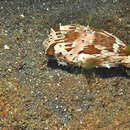en
names in breadcrumbs


Perception Channels: tactile ; chemical
Relatives of D. holocanthus are popular in Asian sushi restaurants. However, D. holocanthus is not normally consumed. Dried, inflated bodies of D. holocanthus are however, a relatively common novelty for tourists on vacation in tropical areas (FLMNH).
The teeth of both the upper and lower jaws of D. holocanthus are fused, forming a solid, heavy beak (Hobson 1974; Waikiki Aquarium 1999). This beak makes cracking the shells of snails, sea urchins and hermit crabs a breeze. With the help of its relatively large eyes, D. holocanthus feeds at night on these delicacies of the coastal zone (Waikiki Aquarium 1999). As for catching its prey, D. holocanthus certainly does not rely on speed. It is actually a slow-swimming predator (Waikiki Aquarium 1999). What D. holocanthus can do is maneuver into tricky positions using its pectoral, pelvic and anal fins. This is especially helpful in complex habitat such as coral reefs. D. holocanthus uses its tail primarily for steering and for occasional bursts of speed (Waikiki Aquarium 1999).
Diodon holocanthus is a nocturnal predator and remains hidden during the day (Hobson 1974; Waikiki Aquarium 1999; FLMNH). Individuals have been observed resting near ledges and shallow caves of the rocky sea floor in the Gulf of California and ledges or holes in the Florida Keys in the daytime (Hobson 1974). In coral reefs around Hawaii and the West Indies, D. holocanthus' main food source is pagurid crabs (hermit crabs) and prosobranch gastropods, which include familiar marine organisms such as abalones, limpets, top shells, periwinkles, boat shells, conchs, moon snails, and whelks (Hobson 1974; FLMNH;Randall 1967; Waikiki Aquarium 1999).
Diodon holocanthus is distributed circumtropically throughout the world (Hobson 1974; FLMNH). In the U.S. it is found along the Pacific coast, the Florida Keys and Hawaii (Hobson 1974; Waikiki Aquarium 1999). It is widespread in the Caribbean and eastern Asia (Hobson 1974; FLMNH).
Biogeographic Regions: indian ocean (Native ); atlantic ocean (Native ); pacific ocean (Native )
Adult balloonfish are found in relatively shallow areas of the ocean. They prefer grassy flats, coral reefs, and mangrove areas (Randall 1967; FLMNH; Nagelkerken et. al 2000). The larvae however, are found in the pelagic (open water) zone (FLMNH). They bob around in their shells for about 4 days before hatching (FLMNH).
Aquatic Biomes: reef ; coastal
Diodon holocanthus, also known as the balloonfish or spiny puffer, can reach lengths from about 30.5 to 61 cm. It has dark patches along its sides and back, but perhaps its most telling feature is the long spines that protrude from all over its body, excluding the fins and face. The spines are actually modified scales, which lay flat against its body most of the time (Waikiki Aquarium 1999). In some relatives of the balloonfish, a toxic chemical, tetrodotoxin, is found in the skin and spines. However, only trace amounts of tetrodotoxin have been found in balloonfish, mainly concentrated in the ovaries (Chen and Chou 1998). In appearance, D. holocanthus resembles its closest cousin, D. hystrix, also known as the porcupinefish. However, an easy way to tell these two apart (without getting too close) is by checking for spots on the fins: D. hystrix has them, while D. holocanthus does not (FLMNH).
Balloonfish expand by swallowing mouthfuls of air or water when attacked by a predator. The balloonfish swallows air, when attacked by avian predators, or water, when attacked by piscine predators (Brainerd 1994). After ingestion through the mouth, the air or water reaches the highly elastic stomach, which has been described as a "large dilatable sac with robust esophageal and pyloric sphincters" (Rosen, 1912). The stomach, which has lost its digestive function, plays a key role in the inflation process (Brainerd 1994). In Diodontidae, the stomach is a simple sac, whereas in Tetraodontidae the stomach is divided into two parts by a pyloric sphincter. As the stomach expands, it pushes the peritoneal lining into the ample peritoneal space. The peritoneal cavity expands towards the head to the mandible and towards the tail to enclose the unpaired fins (Brainerd 1994).
The skeletal structure of D. holocanthus also facilitates inflation. Because the balloonfish lacks pleural ribs and a pelvic girdle, expansion is not as strictly inhibited as in most fish. The vertebral column is also highly flexible. It bends in an arc towards the dorsal side of the fish, allowing D. holocanthus to attain its characteristic spherical shape upon inflation (Brainerd 1994).
In addition to the elastic stomach, generous peritoneal space and skeletal structure, balloonfish skin is also specialized for inflation (Brainerd 1994). The skin of D. holocanthus is highly elastic because of microfolds in the epidermis and collagen fibers of the dermis. These allow D. holocanthus to extend through 40% of its initial length before it begins to stiffen (Brainerd 1994).
Other Physical Features: bilateral symmetry
Diodon holocanthus reproduces through sexual processes, just like most other fish. Sexual reproduction maintains genetic diversity within the species, which is important for preventing disease and adapting to changes in the environment over time. During spawning season, a male pushes a female to the surface and they immediately spawn (FLMNH). The round eggs float in the water. Until they are 10 days old, D. holocanthus larvae retain a thin shell covering, which is then lost (FLMNH). At this time, D. holocanthus begins to develop spines. The larvae metamorphosize after about 3 weeks (FLMNH). After this metamorphosis, fins and fin rays are present, the teeth are formed, and adult olive and brown coloring develops (FLMNH). Dark spots appear on the belly, which may help camouflage the juveniles in floating sargassum from underwater predators such as the mahi mahi (FLMNH). The juvenile loses this underside spotting when it reaches the adult stage. At this point in development, spine elongation and body growth occur. The larval stage of D. holocanthus is yellow with red spots and well-developed functional mouth, eyes and gas bladder (FLMNH ).